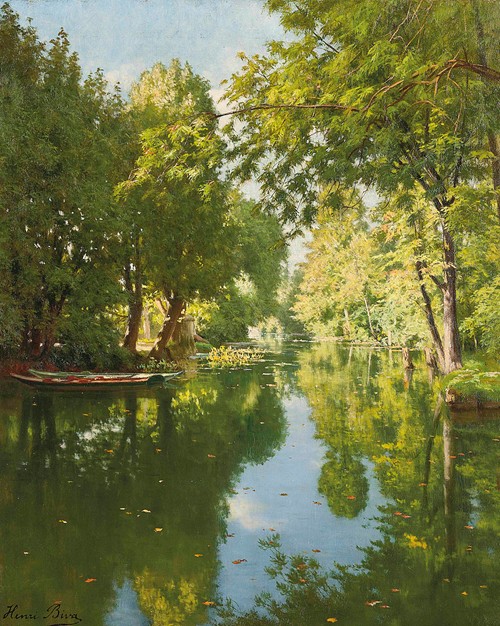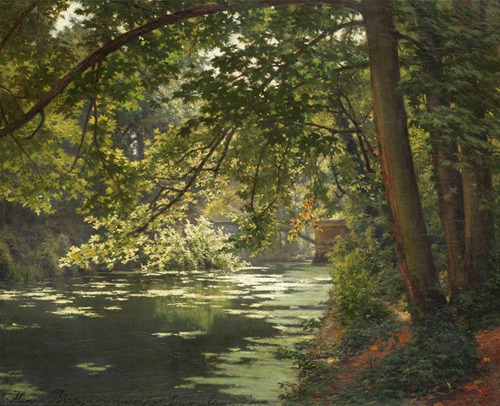






Henri Biva was a French artist, known for his landscape paintings and still lifes. He focused primarily on the western suburbs of Paris, painting outdoors in the plein-air tradition; his style ranging between Post-Impressionism and Realism with a strong Naturalist component. Biva's pictures are characterized by intricate strokes and a pure palette bathed with warm natural light (Biva devoted great attention to light effects). The artist was a member of the Société des Artistes Français and a Knight of the Legion of Honour (Chevalier de la Légion d'Honneur).
Henri Biva was born in Montmartre at 18 rue du Vieux Chemin de Paris (named rue Ravignan after 1867). His official date of birth is 23 January 1848. He grew up in an artistic environment, both within his own family and in the neighborhood in which he lived. His younger brother Paul Biva (1851–1900) also became a painter, as would Henri Biva's son Lucien Biva (1878–1965).
In 1873 Biva studied at the École des Beaux-Arts in Paris, where many famous artists in Europe were trained. His teachers included Léon Tanzi (1846–1913), an esteemed Realist painter, and Alexandre Nozal (1852–1929) a respected landscape artist that perambulated from Impressionism to Post-Impressionism. A trace of both instructors can be contemplated in Biva's work. This, in addition to the lessons at l'Académie Julian with William-Adolphe Bouguereau, Jean-Joseph Benjamin-Constant and Jules Joseph Lefebvre, would ultimately propel Henri Biva to the fore as a career artist. These combined influences explain the skillfully controlled artistry of Henri Biva. The Académie had a very strict and rigorous philosophy toward paintings, yet throughout its history many artists that studied there from 1868 onwards had initiated new artistic movements, or were involved to some extent within them, as was the case of Biva.
Shortly thereafter, during the latter half of the 1870s, Henri Biva began showing his works in the Parisian salon's, while enjoying sufficient commercial success to make his living.
At the Salon de 1879 (which opened on 12 May in Paris at the Palais des Champs-Élysées) Biva exhibited two paintings: Les roses du parc and Pavillon d'été du Chateau de Villeneuve-l'Étang, numbers 293 and 294 in the catalogue.
With his style ranging between Post-Impressionism and Realism, with a pronounced Naturalist temperament—visible in Villeneuve-l'étang (soir) and Après le coucher du soleil—the paintings of Henri Biva gained in popularity amongst private collectors and public institutions.
In 1886 Biva exhibited three works, including Une rue de Ville-d'Avray, La Nuit, at the Exposition Internationale de Blanc et Noir (Louvre, Pavillon de l'enseignement, Rue des Tuileries, Paris, 20 March-20 April 1886). Biva's was awarded the Médaille de bronze at the Exposition Universelle (1900), inviting the attention of the Purchasing Committee, while his teacher Alexandre Nozal was awarded the silver medal.
Upon recommendation of Le Ministre de l'Instruction Publique et des Beaux-Arts, 11 August 1900, Biva was decorated Chevalier de l'Ordre de la Légion d'Honneur, 29 November 1900, and breveted by the Grand Chancelier, 12 December of the same year.
This honorable accomplishment appears to have stimulated further commercial success in the years leading up to World War I. Following the war years, Biva's sales rebounded as he continued exhibiting paintings throughout the 1920s.
Biva exhibited his painting in the Salons des Artistes Francais, Paris, in 1900, 1903, 1904 and 1905. In 1923 Henri Biva was elected vice-president of the Salon d'Hiver (Winter Salon), founded in 1897, first exhibition 1904.
According to his death certificate (avis de décès), Biva died 2 February 1929 at his home in Paris, 72 rue du Château-d'Eau.




